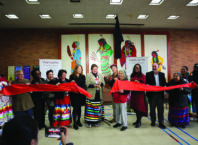By Hannah Yang/MPR
The Minnesota Historical Society will repatriate a hanging rope to the Prairie Island Indian Community that was used in the hanging of the largest single-day mass execution in U.S. history.
The item is known as “the Mankato Hanging Rope” and was used in the hanging of Wicanhpi Wastedanpi (also known as Chaske), one of the 38 Dakota men hanged on Dec. 26, 1862, following the U.S.-Dakota War of 1862. The rope was donated to the historical society and accessioned into the agency’s collections in 1869.
“The Prairie Island Indian Community and its Tribal Historic Preservation Office is grateful for the decision by the Minnesota Historical Society to return the noose used to hang our Dakota relative, Wicanhpi Wastedanpi (Good Little Stars), in 1862, as part of the largest mass execution in U.S. history. What happened to 38 of our relatives will never be forgotten. The repatriation of this item stolen from Wastedanpi’s grave is important to all Dakota people. It serves as a vivid reminder of what happened to our relatives and allow the process of healing within our Dakota communities to continue,” the Prairie Island Tribal Historic Preservation Office said in a statement.
Under the Native American Graves Protection and Repatriation Act (NAGPRA), the rope will return to the Prairie Island Community. Kent Whitworth, MNHS director and CEO said in a news release the rope “is a painful and harmful object that does not reflect the mission and the values of MNHS today.”
“This consultation process has been a deeply meaningful learning experience for all of us at MNHS. I am especially grateful to the Dakota community members who have engaged and provided valuable insights and perspective in recent days and over the years,” Whitworth said in a statement. “We thank everyone involved for honoring the NAGPRA process, and we hope this decision leads to healing for our Dakota friends and relatives.”
The MNHS Executive Council — the agency’s governing board — approved the committee’s determination that the item is eligible for repatriation as both the Unassociated Funerary Object and a Sacred Object with cultural affiliation to all federally recognized Dakota Tribes, including Prairie Island Indian Community.
Through the NAGPRA claim process, the MNHS consulted with Dakota Tribal Nations and relied on prior research by the Santee Sioux Nation, the Dakota NAGPRA Coalition, MNHS staff and current research in the Prairie Island Indian Community’s NAGPRA claim.
MNHS contacted each of the other 11 federally recognized Dakota Tribal Nations following the NAGPRA process and received formal communication from all expressing unanimous support for the Prairie Island Indian Community’s claim.
The agency will submit a Notice of Intent to Repatriate to National NAGPRA for publication in the Federal Register. If there aren’t additional claims within a month of publication of the notice, the item can be physically transferred to the Prairie Island Indian Community.
MNHS will continue to care for the item as a sacred object until the repatriation process is finished.







